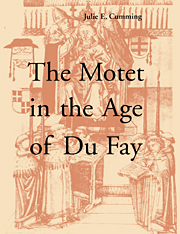Book contents
- Frontmatter
- Contents
- List of tables
- List of musical examples
- Acknowledgments
- Notes to the reader
- Introduction
- Part I Models and methods
- 1 Approaches and analogies
- 2 Subgenre, interpretation, and the generic repertory
- 3 Fifteenth-century uses of the term “motet”
- Part II Motets in the early fifteenth century: the case of Bologna Q15
- Part III Motets in the mid-fifteenth century: the case of the Trent Codices
- Conclusion
- Appendix: Widely disseminated motets
- Notes
- Bibliography of books and articles
- Modern editions of music
- Sources and sigla
- Notes on the index of works
- Abbreviations for subgenre identifications
- Index of works
- General index
3 - Fifteenth-century uses of the term “motet”
Published online by Cambridge University Press: 22 September 2009
- Frontmatter
- Contents
- List of tables
- List of musical examples
- Acknowledgments
- Notes to the reader
- Introduction
- Part I Models and methods
- 1 Approaches and analogies
- 2 Subgenre, interpretation, and the generic repertory
- 3 Fifteenth-century uses of the term “motet”
- Part II Motets in the early fifteenth century: the case of Bologna Q15
- Part III Motets in the mid-fifteenth century: the case of the Trent Codices
- Conclusion
- Appendix: Widely disseminated motets
- Notes
- Bibliography of books and articles
- Modern editions of music
- Sources and sigla
- Notes on the index of works
- Abbreviations for subgenre identifications
- Index of works
- General index
Summary
Before turning to a study of the repertory, we should consider what the term “motet” meant to people in the fifteenth century. The word “motet” is used in three different kinds of sources in the fifteenth century: treatises, archival documents, and music manuscripts. The treatises and archival documents virtually never mention fifteenth-century works that we can identify, and thus it is difficult to know exactly what kinds of pieces are meant by their use of the term “motet.” They do, however, help us to develop some sense of the term's associations and its relationship to other generic labels of the period. I know of two music manuscripts that use the term “motet”; they allow us to associate surviving compositions with the term, and to contrast the “motets” with works belonging to other genres. Manuscript usage of the term can also be supplemented with evidence from manuscripts that are organized by genre. Although the meaning of the term “motet” evades precise definition, the combined evidence from these three kinds of source allows us to make a fundamental distinction between the motet and the prescribed liturgical genres, and to establish a repertory of motets.
Treatises
The motet is frequently discussed in the music treatises of fourteenth-century France, where contemporary examples are often cited. These discussions are primarily concerned with the construction and rhythmic notation of what we now call the French isorhythmic motet.
- Type
- Chapter
- Information
- The Motet in the Age of Du Fay , pp. 41 - 62Publisher: Cambridge University PressPrint publication year: 1999



